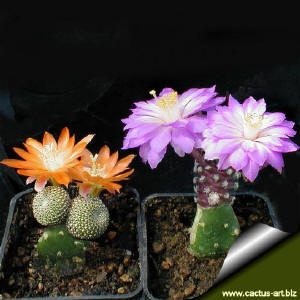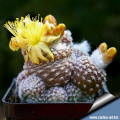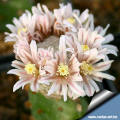|
|
The peculiarity of the grafts on opuntia.
|
|
Back to the
graft index |
|
|
 |
Grafts
on Opuntia are very long lasting compared to the grafts made on other
stocks.
One of the main problems in grafted plants is the formation of a
woody neck at the union point between scion and stock, for example the
grafts made on Hylocereus grow very fast in the first or second year,
but soon the connection point of the two plants becomes suberose and any
further growth is seriously reduced and it is better to detach the scion
and make it re-root or regraft it to another young stock.
I made several experimental hypocotyl grafts to test the duration and
development of different stocks in the time. In the photo you can see
two Ariocarpus grafted when very young seedlings (only few days old) on
two different stocks: The first on a young Opuntia seedling and the
second on a few days old Cereus peruvianus. The Opuntia grows and
enlarges as the scion enlarges, the union is perfect and almost
invisible, no woody neck is formed and after three years no signs of
suberization are visible, a uniform layer of elastic epidermoid has been
formed and the plants keep growing healthily and strongly. The initial
better performance of the plant grafted on Cereus peruvianus has been
nullified. |
|
 |
Very flat and compact growth
|
|
|
The development is typical and conforms to the natural
characteristics of the species. Plants like Strombocactus (in the photo)
maintain a very flat body and don't lengthen in an unnatural way as is
usual for plants grafted on other stock. Some species like Astrophytum
super kabuto grow very flat and it is possible to obtain very nice
specimens. A lot of other different kinds of cacti demonstrate the same
performance when grafted on O. compressa: |

Astrophytum Onzuka |
 |
Spectacular and abundant flowers
also in very young plants.
The plants shown on the left (Mammillaria theresae & Rebutia heliosa)
are not yet one year old, but they are already blooming. This is a very
significant characteristic for one who loves flowers and for who
desires to get quickly fruits and seeds.
But above all these plants are surprisingly beautiful and very
ornamental!!!
Every time that I see one of them in bloom I get enchanted as if it were
the first time I have seen it, I would like to show it to everybody. |
|

Copiapoa lauii |

Mammillaria sancez-mejorade |

Astrophytum myriostigma |
 |
New roots are easily produced at the scion base.
The production
of new roots at the scion base is very important. After a few years, as
soon as the plants reach a good size, it is possible to make the
scion root while it is still grafted. It is possible to bury and hide the
stock deeply in the ground, so it becomes invisible and the scion starts
developing its own new roots and, at the same time, it is still fed and
supported by the stock. If the stock is much too large we can cut
it at 1-2 cm below the point of union, and make
it root like a common
cutting ( for the best root activation we can treat the cutting base with
a rooting powder and let it dry for some days in a shaded room before potting
and watering)
|
|
 |
Strong and healthy root
apparatus.
Opuntia is a
very rustic stock, no problems at all if the soil is too wet, it
does not
rot, it is extremely rare to see a dead one. I find this plant very
adaptable and hardy in every condition, perhaps it likes a little
more water than other cacti.
It isnít even damaged if
kept wet during winter and cold weather.
|
|
 |
The
plants grafted soon make clusters of shoots.
The plants grafted on Opuntia grows flat and compact, branch
freely and quickly forms groups.
|
|
 |
However
Plants on Opuntia have a very natural look.
The plants in the
picture are three years old (at the beginning of the fourth spring of
their life), they were grafted when still very young seedlings on Opuntia
hypocotyl, now the stock is invisible.
Strombocactus disciformis, Rebutia heliosa and Escobaria leei show a
very pleasant appearance, a multitude of blossoms. They are well developed
and healthy but not deformed like many of the common grafts usually seen.
|
|
| |
|
|
|
"English text kindly corrected by John Chippindale" |